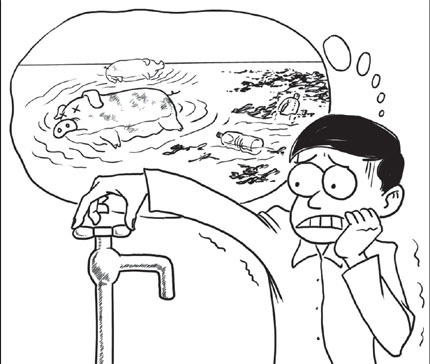Looking beyond dead pigs to understand pollution
- By Wan Lixin
 0 Comment(s)
0 Comment(s) Print
Print E-mail Shanghai Daily, April 3, 2013
E-mail Shanghai Daily, April 3, 2013
|
|
|
Illustration by Zhou Tao |
For weeks the growing tally of dead pigs salvaged from the Huangpu River and its tributaries - now long in the excess of 10,000 - is causing some residents to fret.
The images of these dead swine, many in advanced stages of putrefaction, cannot but be psychologically revolting, especially for those lucky urbanites who traditionally take great pride in their "standard of living."
I do not as a rule give much credence to the so-called scientific explanations, but in this case, I am satisfied with the experts' reassurance that repeated water quality tests suggest the water sourced from the river meets potable water standards.
For one thing, a pig, dead or alive, is part of the living, organic world and does not introduce into any elements that cannot be reduced to something harmless in due course.
As for the viruses or bacteria the swine might have carried, most cannot survive in vitro, or they are diluted to a negligible level, or they cannot interfere with human metabolism.
So I do not turn to bottled water, as some of my nervous colleagues and residents have done.
Vulnerable downstream
If we are in a more charitable frame of mind, we might even congratulate ourselves for, as some upstream pig farmers in Zhejiang Province observe, thanks to more effective measures in outlawing dead pigs as food, the surge in the number of swine carcasses is compelling evidence that the Shanghainese no longer consume as many dead pigs as they were wont to.
Being situated at the estuary of a river - any river - is generally perceived as an economic plus, so much so that few of us realize how vulnerable we in the downstream can be.
The vulnerability is deeply discomforting for anyone who has faith in all the advantages he or she has taken for granted for living in a post-modern metropolis like Shanghai.
So when daily confronted with blatant pollution accidents or scandals, most of us civilized urbanites tend to take the moral high ground, indignant but somewhat detached, little aware that we are sometimes the culprits, sometimes victims, and most of the time both the culprits and victims.
Take for instance the fate of a river flowing near a village in the Dongchuan District in Kunming, capital of Yunnan Province, a province home to such pristine tourist destinations as Dali, Shilin (Stone Forest), and the awe-inspiring, snow-capped Yulong Mountain.
The Beijing News reported on Monday that discharge of mineral waste from a copper mine has turned the river to an opaque, milky color, as demonstrated by a villager holding a bottle of river water beside a bottle of mineral water.
In a section where the river flows into another river, there appears to be a clear line of demarcation separating the milky substance from the body of yellowish water that comes from another river.
Milky water
Another picture shows the fairly obvious extended structure that conveys the waste water to the river.
Three naked, heavily tanned village kids are playing by the river, with the whitish, foamy substance clinging to their backs, face, and hair.
One of the captions reads that on March 20 villager Liu Deping is carrying home two buckets of the milky water on a shoulder pole.
He knows the water is contaminated, but has no choice.
His family, parched for water, will wait at least three days for some of the chemicals to settle before they can scoop out the upper layer for use, although no amount of sedimentation can remove the pungent taste of the water.
Another elderly villager surnamed Wei is watering his peanuts with the milky water.
Crops yield little on such water, and are prone to disease and pests.
Following irrigation, a whitish crust will cover the surface of the soil.
The waste comes from the nearby mineral-extracting factories.
The copper-rich Dongchuan District, an important copper producer since 1949, is dotted here and there with dozens of copper mining plants of various scales.
We are culprits to an extent because nearly all of us are copper consumers (copper plumbing has become a salient feature of more elegant urban life.)
We are also victims.
These slimy, whitish substance flows 70 kilometers before draining itself into the Jinsha River, which will flow thousands of kilometers before ending up in the Yangtze River.
Victims and culprits
In this connected world, it's easy to point an accusing finger at those ruthless business people who are trying to make a profit by despoiling the natural beauty, or local governments who are complicit in the game.
But according to the standard narrative, everyone in this world (especially those in impoverish regions) is entitled to the pursuit of happiness, aka material affluence.
And in those backwater areas, the only thing that enables the local people to participate in this global prosperity game is to offer their resources at a price that is competitive.
Unlike the dead pigs in the Huangpu River, the components of this milky substance is toxic, for they are substances that have lay dormant underground for millennia, and are elements extraneous to the biosphere.
In this hyperlinked world, every body will ultimately pay for the convenience he has come to take for granted, for ultimately the Yangtze River empties itself into the Pacific.







Go to Forum >>0 Comment(s)